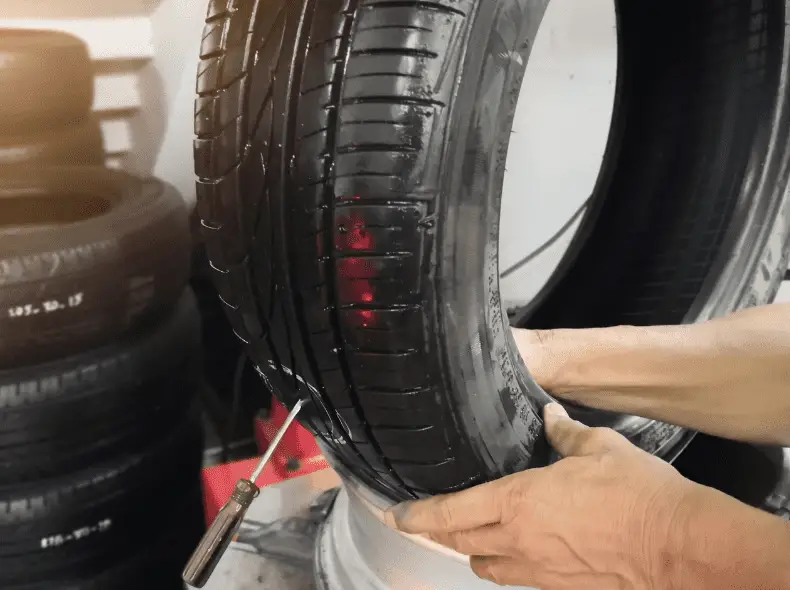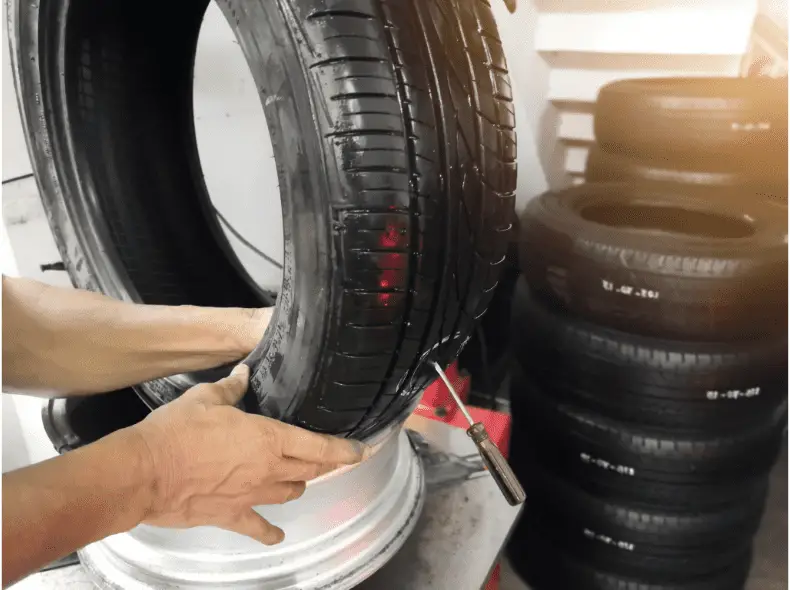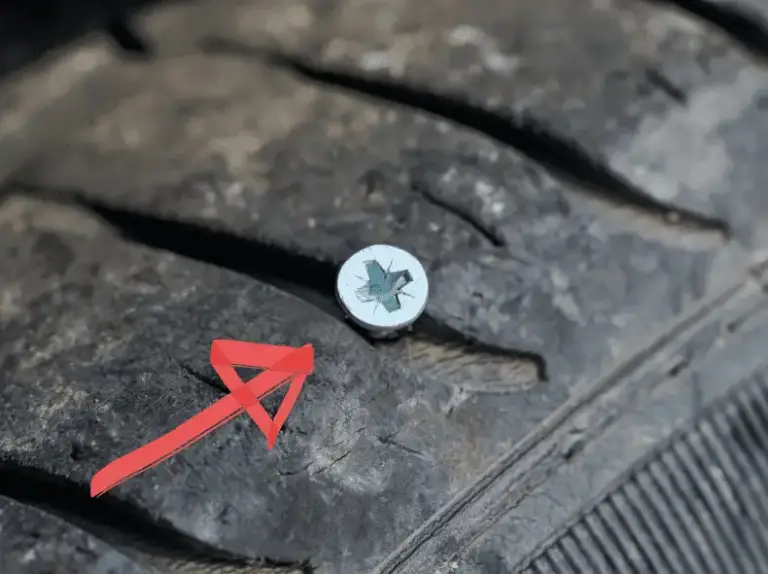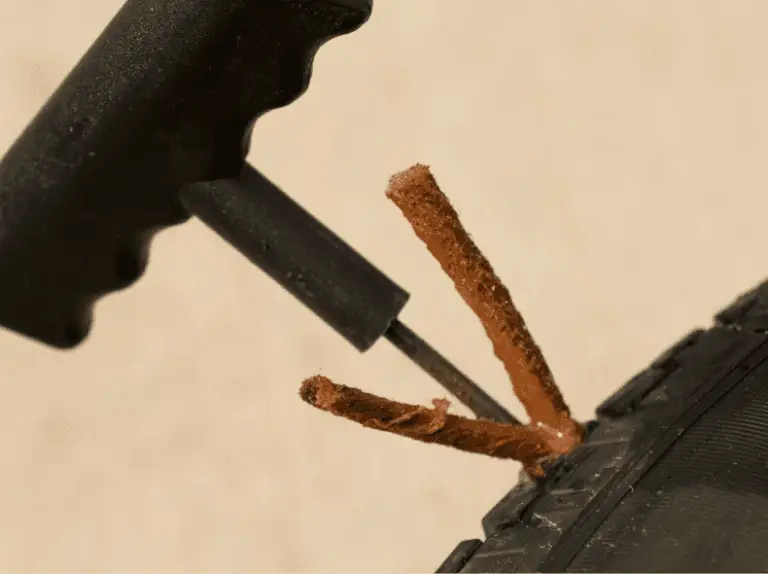When it comes to tire repair, many tire shops refuse to do tire plug repairs. This is because tire plugs can be a temporary fix that doesn’t address the underlying issue causing the tire to have the puncture.
Instead, tire shops prefer to fix the problem with a patch plug combination repair designed to seal the puncture rather than just plugging the hole.
Still, many of us still plug our tires as they can be a cheaper option.
Tire plug kits can be purchased at most auto parts stores and many online retailers. These kits are relatively inexpensive and cost anywhere from $10 to $25, depending on the size and quality. The average cost of a tire plug kit is approximately $15.
What is the Difference Between Plugging a Tire and Patching a Tire?
Plugging a tire involves inserting a plug or patch into the punctured area from the outside of the tire. This plug will be secured using a special adhesive, typically made from rubber and sometimes encased in leather.
The puncture is generally sealed within minutes, and the tire is ready to be driven, albeit only temporarily.
Patching a tire, on the other hand, requires removing the tire from the wheel.
The inside of the tire will then be scraped and cleaned before a patch is applied to the punctured area. This patch will be secured using adhesive, and the tire will be inflated and placed back on the wheel.
Regarding cost, patching a tire is typically more expensive than plugging one.
This is because the materials, tools, and labor required for patching are more costly than plugging.
However, the long-term cost savings from patching a tire can be significant, as it can extend the life of the tire.
Plugging Kit Contents and Costs
without having to pay for a professional repair or replacement. DIY tire plugging kits are a great way to save money and get your car back on the road. So what do these kits contain?
The most important components of a DIY tire plugging kit are the plug, the cement, a needle tool, and a reaming tool.
The plug is a piece of rubber, often encased in leather, that can be inserted into the puncture, while the cement seals the plug and ensures that it won’t come loose. The reaming tool makes the puncture large enough to accommodate the plug.
Before you can plug the tire, you’ll need to use the reaming tool to make the puncture large enough to fit the plug.
This is an important step, as the plug needs to be properly inserted to be effective. Once you’ve reamed the puncture, you’ll need to apply the cement to the plug and use the needle tool to insert the plug into the hole.
A DIY tire plugging kit will generally cost around $20-30
Costs of Plugging A Tire Badly
Let’s look at some costs associated with incorrectly plugging a tire.
1. Increased Risk of Tire Damage:
Improperly plugging a tire can create a weak spot, making it more vulnerable to further damage. This can lead to a serious blowout, which can be potentially dangerous.
2. Loss of Tire Balance:
Plugging a tire incorrectly can cause the tire to become unbalanced, leading to decreased fuel efficiency and increased wear and tear on the vehicle’s suspension and vibrations.

3. Reduced Tire Life:
Plugging a tire poorly can reduce the life of the tire, meaning you will have to replace it sooner than expected.
4. Reduced Safety:
Poorly plugging a tire can lead to decreased safety. This can range from poor handling to decreased tire pressure, which can be dangerous when driving in wet or icy conditions.
Plugging a tire correctly is important for many reasons. Taking the time to repair your tire correctly and safely can save you money and help keep you and others safe.
Often read next: Is It Safe To Plug A Tire Sidewall?
Advantages of a Tire Shop Patch Repair
While a DIY plug repair may seem like an easier and more cost-effective option, there are several advantages to having your tire patched by a tire shop that makes it the better choice.
1. Quality:

When patching a tire, the quality of the patch is essential for the repair to be successful. Tire shops use professional-grade patches designed to last and provide a stronger bond than a DIY plug repair.
This ensures that the repair will be safe and reliable.
2. Expertise:
Tire shops employ technicians who are highly trained and experienced in tire repair. These technicians can properly assess the damage to the tire and provide the best option.
This eliminates the guesswork of a DIY plug repair and ensures that the repair will be done correctly the first time.
3. Safety:
The safety of the repair is of utmost importance when it comes to tire repair.
The technicians in a tire shop will use the proper tools and techniques to ensure the repair is safe and effective. A DIY plug repair could lead to a dangerous situation.
4. Value:
While the cost of a tire shop patch may seem higher than a DIY plug repair, it provides a much better value in the long run.
The patch’s quality and the technician’s expertise ensure the repair will be done correctly and last a long time.
This will save you money in the long run by avoiding unnecessary repairs or replacements.
Conclusion
Overall, a tire shop patch is the better option for repairing a tire. The patch’s quality, the technician’s expertise, and the repair’s safety make a tire shop patch the better choice.
The cost may be higher, but the value of a properly installed patch far outweighs the cost of a DIY plug repair.


![Tire Plug Vs Patch Cost [ANSWERED] tire-patched](https://carzaza.com/wp-content/uploads/2023/12/tire-patched-300x224.png)

![How Do Tire Plugs Work? [Answered] tire-repair-kit](https://carzaza.com/wp-content/uploads/2023/12/tire-repair-kit-300x224.png)





